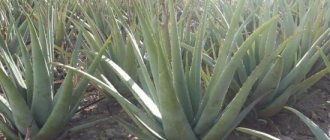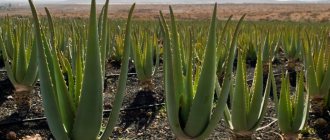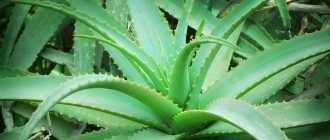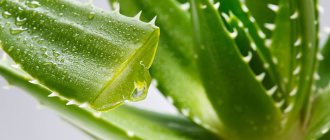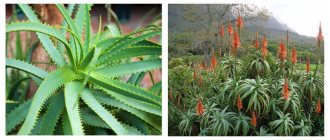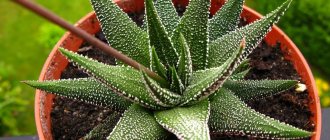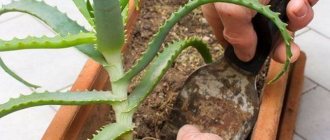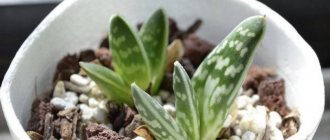What types of aloe are there: photos, names and descriptions of indoor varieties and medicinal varieties
The name aloe - aloe in Latin - probably comes from the Greek language, formed from the fusion of words meaning "giving" and "salt", indicating a bitter-salty taste. Transformed into Latin, it became aloë, “bitter.” It is quite possible that the original origin of the word is from the Arabic alloeh: “a substance that is bitter and bright.” A similar-sounding name, Ahal, appears in the Bible, suggesting linguistic roots in Hebrew.
The genus of aloe belongs to the Liliaceae family , according to the rules of traditional taxonomy, having previously been separated into the family of the same name. With the advent of the APG classification system, the plant began to be classified as Asphodelaceae. The genera Gasteria, Haworthia and Kniphophia have the same method of growth and are its closest relatives.
The succulent is often confused with a cactus, which is not surprising if you remember where its homeland is: Africa, Madagascar, the Arabian Peninsula. Various species of aloe are so widely cultivated throughout the world that it is impossible to identify its natural distribution area.
Aloe is a valuable plant. Its raw materials are rich in polysaccharides, allantoin, flavonoids, prostaglandins, phenol compounds, essential oils, choline, thiamine, cyanocobalamin, carotenes, ascorbic acid, potassium, zinc, copper, magnesium and other useful substances that determine its medicinal properties.
The Plant List, a joint development of Kew, the Royal Botanic Gardens in the UK, and the Missouri Botanic Garden, lists 558 aloe species, all of which are named in the project's lists.
The photo shows the types of aloe whose names are most widely known:
However, few plant species have medicinal properties. Only varieties of aloe derived from the species described below are classified as medicinal.
Aloe vera, which is real, rightfully takes first place. Used in gastroenterology for the treatment of gastritis, enterocolitis, gastric and duodenal ulcers; ophthalmology for complex therapy of keratitis, blepharitis, conjunctivitis, in cases of vitreous opacification; therapeutic cosmetology for sensitive and problematic skin; in folk medicine as an anti-inflammatory agent for mucous membranes and wound healing.
It grows in the southern half of the Arabian Peninsula, in Morocco, Mauritania, Egypt, the Canary Islands, Cape Verde, and the island of Madeira.
Its varieties, depending on their origin, differ in the color of the leaves (they can be blue or green). In addition, Aloe chinensis , the leaves of which are covered with white round spots.
Aloe arborescens , known as agave, was well studied in the mid-twentieth century. Its leaves and condensed juice (so-called sabur) are used to make laxatives, choleretic, anti-burn agents; they improve appetite and the secretion of the digestive glands.
Distributed in South Africa: Mozambique, Zimbabwe, Malawi, Swaziland.
Its subspecies known as Aloe arborescens var. natalensis has been tested in vitro since the 1980s, showing fungicidal activity and the ability to inhibit the growth of staphylococcus, streptococcus, diphtheria and dysentery bacilli.
These types of aloe have largely displaced its Socotrin variety, which came from the island of the same name in Yemen, but it has not lost its local significance.
The plant in the photo is an indoor variety of aloe flower:
Of course, no matter what types of aloe there are, they all have something in common in appearance. This is a typical succulent plant with thick, elongated leaves, most often arranged in the form of a rosette. Succulents are species that have special tissues to retain the moisture they need to survive in dry and hot climates. In extreme conditions, the plant will simply close the pores on the leaves so as not to lose a single drop of precious liquid.
The flowers of different types of aloe can be yellow, white, red or orange, but will always be tubular, located on a long peduncle. Alexander Kuprin, in one of his works, gives a very vivid description of the aloe flower: “Lush clusters of snow-white flowers of unprecedented beauty bloomed on the high green stem of the Agave, which emitted a wonderful, indescribable aroma that immediately filled the entire greenhouse.”
In all types of aloe, only mature plants bloom, and, in combination with developed leaves, which Vasily Botkin compared to protruding daggers, the spectacle is enchanting.
But not all types of aloe plant look the same. The appearance of the flower, the color and arrangement of the leaves are the diagnostic features that make it possible to distinguish different types of aloe and distinguish individual varieties from them.
For example, Aloe variegata (tiger aloe) has light transverse stripes “painted” on the leaves, and the leaves themselves are arranged one above the other in a tight spiral, but in the descuana variety the shades of the spots are bluish, and in the pearl variety they look like light growths.
The already mentioned agave is more reminiscent of a tree, for which it received its second name, the soapy one has leaves covered with a mosaic of pale spots, the ferox has a reddish tint, and the variegated one looks like exotic emerald marble.
Here are photos and names of indoor aloe species:
True, variegated and tree-like aloe vera take root best as a houseplant: they are the easiest to care for.
For decorative purposes, breeders develop hybrid varieties of aloe. The most popular of them:
Black Gem is a rosette plant of miniature plants that changes its leaves from bright green to red when exposed to sunlight for long periods of time.
Donnie - has variegated dark green foliage with pink edges.
Snow flake - leaves are almost completely white, with green shading.
Blue elf - derived from aloe squat, with blue-gray leaves and orange flowers.
Pink blush - distinguished by reddish-pink edging and shading on the leaves.
Christmas Carol - known for its bright red thorns on green leaves.
The presented photos show aloe varieties in all their diversity:
The most common flowering species
Aptenia care and reproduction: varieties and home conditions
There are approximately 300 known flowering varieties of this succulent. Most of them bloom in spring or early summer. The most popular types:
- Aloe Vera - blooms with bright orange flowers and is considered the most common in indoor floriculture.
- Fan-shaped - its leaf plates are arranged accordingly, and the buds are painted red.
- Aloe Jackson - distinguished by purple-violet tube flowers.
- Aloe Descoings - this variety has triangle-shaped leaves and yellow buds.
- Tree aloe - it is characterized by a variety of flower shades - bright red, light yellow, deep orange and pink.
- Camperi - distinguished by a branched peduncle, at the ends of which there are brushes with scarlet buds.
- A beautiful aloe - its bell-shaped flowers have a purple-coral tint.
- Soapy - the tubular buds of this species are colored in red, yellow or pink tones with specks of a darker shade.
- Frightening (aka Terrible) - the distinctive feature of the variety is the thorns on the leaf blades and bright orange-scarlet inflorescences.
- White-flowered is the rarest indoor species; it came from Madagascar and is distinguished by white-cream buds.
Inflorescences of different species differ in color and shape
How to properly care for an aloe flower (with photo)
An alternative to a prickly cactus can become a pleasant ward for the owner, but how to properly care for an aloe flower?
Endurance and unpretentiousness are the main qualities due to which aloe does not require specific growing conditions. A native of Africa is not spoiled by air humidity: it tolerates dry air, even in apartments with central heating.
For the same reason, it does not require abundant watering: maintain moderate soil moisture; Water less in winter.
Important! Avoid stagnant waterlogging; it leads to damage to the root system, which will become noticeable no sooner than the rot rises up the stem to the leaves, and it will be difficult to save the plant.
Growing aloe at home requires selecting a suitable location: sunny, in summer it is best to place it outdoors in a protected place. Despite its southern origin, being a house flower, aloe does not approve of too high temperatures: room temperature, coolness is necessary in winter. Optimal conditions are 18-20 °C, then the plant will develop quickly.
In different countries, especially in the wild, each type of aloe grows in soil that is slightly different in composition, but, regardless of the variety, an alternative substrate is suitable for all of them: a flower soil mixture with 1/3 sand.
When preparing the soil yourself, you need to take into account that in nature the plant takes root on dry, clay soils with a high iron content and good aeration. Botanists speak well of a mixture of turf, leaf soil, humus and coarse sand.
Sections of turf soil are made on fertile plains (soil layer 7-10 cm thick), carefully monitoring the absence of unrotted inclusions of organic origin. Leaf soil is used as a leavening agent. Only rotted leaves are allowed in it: tougher and harder elements are removed. River sand is washed well before adding to the soil mixture.
What to do if the plant starts to bloom?
In the wild, Aloe Vera produces a flower stalk topped with a cluster of orange tubular flowers. It is very difficult to see a plant in all its glory in a house or apartment. To do this, it is necessary to create natural growing conditions: shorten and increase day length, change temperature and illumination. Sometimes flowering provokes an exit from the dormant period.
The plant throws out a peduncle with a brush of orange tubular flowers
How to organize a rest period?
In the fall you need to stop feeding. The plant is no longer watered every week, but twice a month; with the onset of winter, this is done once every 30 days. Water should not saturate the soil, but only moisten it. The pot of Aloe Vera is placed away from radiators on a bright and cool windowsill (12–14 ºC).
In March, the plant is transplanted into a new pot and gradually accustomed to the sun's rays: taken out to a warm balcony, veranda, or window on the south side. First, they move it for half an hour, the next day they remove it for an hour, and so they gradually increase the duration of “sunbathing” until the whole daylight hours. Also, in spring, they begin to fertilize and water abundantly once a week.
Care for growing aloe at home: feeding and transplanting from pot to pot (with video)
Caring for the plant at home, the gardener provides it with additional feeding: in the summer, every 3 weeks he applies fertilizer for cacti. In nature, the renewal of the organic and mineral composition of the soil is ensured by rain, the influence of wind, and the vital activity of birds and animals; at home you will have to do this yourself.
Sooner or later, the flower will need to be replanted: adult plants, if necessary, are replanted, on average once every 2-3 years, young plants - once a year. Aloe replanting is required when the flower begins to grow out of its pot, so transfer it to a pot one-fifth larger than the previous one.
The best time for such events is spring and summer, when the plant will receive enough natural light and the optimal room temperature for it is maintained naturally.
When replanting a plant, its roots can be treated with charcoal: it is a natural antiseptic and will prevent the death of the flower if the root system is accidentally damaged or infected. Place a layer of sand or perlite about 5 cm thick on the surface of the substrate - this will prevent the lower part of the stem from rotting.
You can watch the process of caring for aloe at home in the video below:
Growing in the garden
A completely unusual thing for our latitudes would be to plant an indoor aloe vera flower in open ground on a personal plot. As it turned out, the hardy plant also adapted to outdoor conditions. If you choose this method, care will be greatly simplified: the need for periodic replanting and compliance with the watering regime disappears.
To create comfort for aloe in an open space, the future planting site is cleared of weeds, and the hole is filled with soil familiar to succulents with a 40 percent sand content. Before planting, the roots of the plant should be dried in a dark place for three days. Now you can safely place the home healer directly in the prepared soil. To prevent uninvited weed neighbors from settling in the tree trunk again, florists recommend filling the area around the aloe with stones, and at the same time adding elements of desert decor to the garden. Spoiled leaves that have lost their decorative properties are used as a medicinal and cosmetic product for skin and hair, and as a growth stimulant for vegetable and horticultural crops. The leaves, cut with a thin knife, are wrapped in opaque paper and stored in the refrigerator for at least 10 days to complete the fermentation process. Then they squeeze out the juice and use it for good at their own discretion.
Pre-winter preparation consists of insulation with covering material and wrapping with film. In winter, watering is stopped.
Planting and caring for an aloe plant at home: method of propagation by seeds
Experts in growing and caring for aloe distinguish three main methods of propagation: by lateral shoots, shoot cuttings or seeds; they are all applicable at home.
Growing from seeds is the most labor-intensive and painstaking method of propagating aloe, but with its help you can get a real collection of indoor aloe species, because many stores sell mixtures of different seeds. Sowing is done in the spring, in March-April, using small bowls and soil consisting of turf, leaf soil and sand in a ratio of 2:1:2. Water moderately as the seedlings dry out, after which the seedlings are transferred one at a time into small pots.
The soil in them consists of turf and leaf soil and sand in a ratio of 2:2:1, with the addition of charcoal or brick chips. After a year, the plant is considered mature.
It is recommended to treat aloe seeds before planting so that the young flower quickly adapts to home conditions and better accepts care. This can be done in three ways: using potassium permanganate, copper sulfate or boric acid, and aloe juice as a biostimulant.
The potassium permanganate solution for seed disinfection should be weak and pinkish in color. It will protect the shoots from pathogenic bacteria. You can add a little solution to the substrate for the same purpose, but guided by a sense of proportion, since potassium permanganate is a strong oxidizing agent and can burn the seeds if the concentration is exceeded.
Undiluted aloe juice acts as a nutritional cocktail for the seeds. It is mixed with beet or tomato juice, left for a day, after which a gauze bag with seeds is placed in this mixture. In a couple of hours they will be ready to land.
A solution of boric acid or copper sulfate will provide protection against parasites and fungal spores. Keeping the seeds in the solution for a quarter of an hour will provide effective disinfection, after which the seeds, washed with running water, are planted in the soil.
Aloe - medicinal properties, use in medicine
Photo of aloe vera in a pot
Aloe juice is used as a means to rejuvenate the skin and reduce irritation. A significant effect is provided by the juice from freshly squeezed leaves, which is diluted with water and washed, used as a lotion.
Indications for use of aloe vera juice:
- weakness, vulnerability, lack of vitamins and minerals,
- strengthens the immune system,
- stimulates the production of lymphocytes, and increases phagocytosis (the process of digestion of individual particles),
- adds strength
- diseases of the digestive system, constipation, diarrhea, stomatitis, enteritis, stomach ulcers.
- regulates the secretion of hydrochloric acid and pepsin, normalizes the pH of gastric juice to 5 - 5.5, destroys microorganisms that cause inflammation,
- improves digestion and cleanses the intestines
- skin and fungal infections, candidiasis, eczema, boils, difficult to treat wounds, burns and frostbite
- destroys fungal bacteria, stimulates cell growth, reduces pain and swelling, stops bleeding and speeds up the healing process
When drinking juice internally:
- the blood is purified, various poisons are neutralized, including mushroom poisoning
- blood circulation improves, blood vessels are strengthened and their destruction slows down
Recommended for use by people suffering from dry and sensitive skin, and also as a natural antibacterial deodorant.
Treatment of allergic diseases
- Rhinitis - reduces inflammation and swelling of the mucous membrane.
- Diarrhea - stopping diarrhea.
- Atopic dermatitis - nourishes the skin, perfectly moisturizes, prevents dangerous infections and heals old wounds.
- Relieves itching and inflammation.
- Diabetes mellitus - lowers blood sugar levels.
- Atherosclerosis - dilates and clears blood vessels
- Relieves swelling and swelling
For hair loss, aloe is used to strengthen the roots. At high doses, in pregnant women, it causes accumulation in the colon and stagnation in the pelvis, which leads to miscarriages.
Ointments are made from aloe juice, which are effective for skin lesions, ulcers, and heal open wounds and burns. Preparations based on aloe are used as biostimulants for pharmaceutical ingredients that improve immunity and chronic inflammation of the respiratory tract.
Propagation of aloe flower by cuttings, top and leaf at home
Propagation of aloe by cuttings is faster and easier; this is one of the most popular methods.
It can be used all year round, but it is preferable to transplant aloe cuttings in the spring and summer, when it is easiest to provide the young animals with light and warmth at home. The cut shoots need to be dried for one or two days, then powdered with crushed coal. It will take away any residual excess moisture and disinfect the cut area. After this, the first planting is carried out - in wet sand to a depth of 1 cm.
After planting, the humidity level in the sand is maintained: it should not dry out, but it should not be flooded. There is no need to cover the plant, because it needs a constant flow of fresh air. By the seventh day, when roots form, the seedling is transferred to a pot where it will mature.
To propagate aloe from the top, it is carefully cut from the plant and placed in a vessel filled with water. Replant when the shoot forms several roots.
For the last method of propagating aloe - by leaf - the grower will have to carry out a small amputation at home. The leaf is completely separated from the stem near the base and removed in the shade until it dries. After this, the cut site is treated with charcoal and placed in a pot with a substrate to a depth of at least 3 cm - this is optimal for the speedy start of the rooting process.
Thus, planting and caring for aloe shoots is very simple, even in a home greenhouse. Regardless of the method of propagation and the type of flower, aloe does not make high demands on the owner.
Optimal soil composition, light, coolness and a balanced amount of moisture - that’s all the prickly doctor needs to turn green and delight the gardener’s eye.
Care rules on which flowering depends
The natural habitat of the agave is desert areas with dry and hot air, open to direct sunlight. To achieve aloe flowering, you will need to create a comfortable environment for it.
Priming
Aloe tree - what is it, description of the plant
Soil with a neutral or slightly acidic reaction is preferred. You can purchase a ready-made mixture or prepare it yourself from turf soil, river sand and humus. Drainage must be placed at the bottom of the pot.
Note! On the second day after watering, the soil around the succulent should be carefully loosened.
Fertilizers
The plant will develop properly with regular application of mineral fertilizers. To do this, use ready-made complex compositions for succulents strictly in accordance with the instructions.
Watering
The desert flower should not be watered too often, as waterlogging is detrimental to it. For this purpose, settled water is used.
Temperature and humidity level
Although most varieties of aloe can withstand temperature changes from +6 to +28 degrees, it is advisable to maintain an optimal temperature indoors within +18-20 degrees. Humidity should be kept at an average level; there is no need for additional spraying.
A young plant must be replanted annually
Why do the leaves of an indoor aloe flower turn yellow and dry?
The photo shows a healthy indoor aloe flower:
However, despite all efforts, it happens that the pet begins to waste away. Let's look at the reasons for possible difficulties.
It was mentioned above that for optimal development of a flower, the soil in its pot must be periodically fed with cactus fertilizer.
Excessive depletion of the substrate will inevitably affect the plant: most often it is the answer to the question of why aloe leaves turn yellow.
Fertilizing is not carried out if the plant was replanted less than three weeks ago. During periods of prolonged rain, cool and cloudy weather, plants slow down their metabolism, so fertilizing should be reduced. The optimal composition of mineral fertilizers is considered to be with a high content of potassium, calcium and phosphorus - microelements that are essential for the health of the succulent.
If the grower misses the time for replanting, the root system becomes cramped in the pot, the development of the plant stops, and the supply of nutrients in the substrate is depleted. The flower begins to “lose weight,” that is, to draw out the necessary resource from its own external organs - this is why the tips of aloe leaves dry out.
In this case, you need to transfer outside the schedule. Do not water the plant for several days to make it easier to remove from the pot. If the roots have grown to the sides, the new pot should be wider. If the root system goes deep, you can take a pot of smaller diameter, but high. In the new container the plant should be free and spacious.
Another reason why aloe dries is not enough watering. The succulent wastes moisture without receiving the necessary amount to maintain the supply of fluid in the tissues, and the leaves begin to thin out.
What are the differences between Aloe Vera and Aloe arborescens?
Aloe Vera is a type of aloe succulent plant. A distinctive feature of Aloe Vera from agave is that the first has a rosette of leaves, unlike the second plant, which has a trunk and leaves on the sides. Aloe vera is typically grown in plantations for cosmetic and medicinal purposes. It is the juicy and fleshy leaves that are of interest, which are subsequently cut off when the plant reaches four years of age. While in agave the trunk is used for the same purposes, not the leaves.
Aloe Vera / Aloe arborescens (Agave)
Why does aloe still turn yellow if the soil is sufficiently fertilized and aerated?
As you know, the healthy green tint of plant foliage is due to the presence of chlorophyll, a pigment that helps carry out the process of photosynthesis. With its help, the flower feeds, develops - simply put, lives.
Photosynthesis occurs only in the presence of a sufficient amount of light for a given species: if the plant is too shaded, the metabolism is disrupted, the first symptom of which is a pathological change in the color of the leaves. You need to move the flower pot to a sunnier place, and over time the pigmentation will be restored.
In addition, being in an unfortunate place with limited access to light, the plant begins to reach for its source, which is another reason why the leaves and stems of aloe dry and weaken.
The color of the spots will help the grower make the correct diagnosis. Brown spots indicate a lack of moisture, as does a change in the elasticity of the leaves. If the spots are soft and dark, the flower is most likely affected by a fungal infection; you need to treat the leaves with an antiseptic.
Black spots indicate severe contamination; you need to wipe the plant from dust more often. Redness is a natural reaction to bright lighting, characteristic of agave plants; there is nothing to worry about.
If the leaves suddenly begin to fall off, the aloe was watered with too cold water. Keep the watering can in an area at room temperature, ideally close to the plant pot.
If the leaves wither, turn pale and look sickly, there is too much water in the ground. The watering regime must be changed as quickly as possible before the roots of the plant begin to rot. If the plant begins to turn yellow in the stem, stops growing and falls to one side, it has already contracted root rot. In this case, you need to remove the plant from the pot, inspect and remove all flabby and rotten roots, and cut them off.
Throw away the soil from the pot, wash and disinfect it. A mixture of peat and sand is poured into the pot, where the flower is planted for re-rooting. Water sparingly, using a tray, wetting only the bottom layer of soil. The next watering is not carried out until the soil is completely dry.
The amount of moisture is directly proportional to the temperature of the flower and the amount of sunlight.
If rot has affected the stem, the lower part of the flower is completely cut off until healthy tissue remains. The cut area is sprinkled with crushed coal, dries for 1-2 days, treated with Kornevin and planted as described above.
If small black dots are found on the leaves, the plant is affected by thrips, and the dots are traces of their excrement. The diseased flower is isolated and treated with actara according to the instructions. Repeat 4 times with breaks of 7-10 days. All house plants are given preventive maintenance.
If the green leaves begin to dry quickly, this means that the flower has developed dry rot. She is incurable. For prevention, the entire home collection is periodically treated with systemic fungicides.
Growing problems, diseases and pests
Evergreen cypress - what it is and what it looks like
The plant rarely gets sick, but can be attacked by scale insects. Pests are collected from the leaves yourself. If watered incorrectly, the roots may rot. Prevention of this problem is considered to be proper care, which involves moderate watering.
Scale insects on aloe leaves
Other problems during cultivation include the following:
- If the tips of the leaves begin to dry out, this means that the root system has grown greatly and there are not enough nutrients in the soil. The solution to the problem is to transplant into a looser pot.
- Curling of aloe leaves indicates that it needs more careful care - it is worth wiping the leaves from dust with a damp cloth.
- If the leaves turn yellow and become watery, then there is a problem with watering. It is recommended to stop it for a while.
- Falling leaves also indicate improper watering. The succulent should be moistened with water at room temperature.
Aloe vera is often used as a houseplant. This is due to the ease of care and the presence of beneficial properties of the plant. The decorative qualities of the succulent are high, which is why even non-flowering aloe is pleasing to the eyes of household members.
Chemical composition of aloe
Aloe juice contains more than 200 active components. Let's name the most important of them:
- anthraquinones - aloin (barbaloin), isoaloin, 7-hydroxyaloin A, 5-hydroxyaloin A. Aloin gives a characteristic bitterness and is responsible for the effect of aloe preparations on the digestive system - it contracts the smooth muscles of the intestines;
- allantoin – has an astringent and softening effect;
- mono- and polysaccharides;
- enzymes;
- vitamins A, C, E, group B;
- amino acids;
- minerals: calcium, copper, selenium, chromium, manganese, magnesium, potassium, sodium, zinc and others;
- saponins;
- organic acids;
- phytoncides – biologically active substances with bacteriostatic and antifungal effects;
- esters and resins;
- phenols;
- plant hormones auxins and gibberellins, which have anti-inflammatory and regenerative properties.



